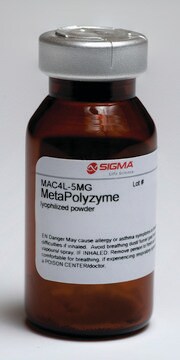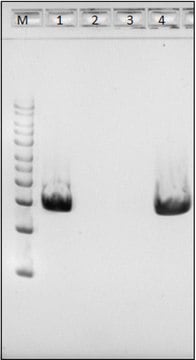SAE0092
Mutanolysin from Streptomyces globisporus ATCC 21553
free of DNA contaminants, suitable for Microbiome research, lyophilized powder, ≥4000 units/mg protein (biuret)
Synonym(s):
Mutanolysin
About This Item
Recommended Products
biological source
Streptomyces sp. (Streptomyces globisporus ATCC 21553)
form
lyophilized powder
specific activity
≥4000 units/mg protein (biuret)
mol wt
23 kDa
~18.5 kDa
feature
DNA free
concentration
≥40% protein
technique(s)
nucleic acid detection: suitable
suitability
suitable for cell lysis
application(s)
life science and biopharma
shipped in
wet ice
storage temp.
−20°C
Related Categories
Application
Mutanolysin is a muralytic enzyme, suitable for usage in isolation of nucleic acids, from Gram-positive bacteria (e.g. Listeria, Lactobacillus, Lactococcus),(8) and also from other bacteria that are difficult to lyse with lysozyme only.
Biochem/physiol Actions
Features and Benefits
Microbial DNA free, minimizing DNA contamination from reagents in workflow.
Suitable for the isolation of nucleic acids from Gram-positive bacteria, including Listeria, Lactobacillus, and Lactococcus.
Unit Definition
Physical form
Legal Information
Signal Word
Danger
Hazard Statements
Precautionary Statements
Hazard Classifications
Resp. Sens. 1
Storage Class Code
11 - Combustible Solids
WGK
WGK 2
Flash Point(F)
Not applicable
Flash Point(C)
Not applicable
Certificates of Analysis (COA)
Search for Certificates of Analysis (COA) by entering the products Lot/Batch Number. Lot and Batch Numbers can be found on a product’s label following the words ‘Lot’ or ‘Batch’.
Already Own This Product?
Find documentation for the products that you have recently purchased in the Document Library.
Customers Also Viewed
Articles
Enzymatic cell lysis and protoplast prep processes demystified, revealing complex enzymatic reactions during sample preparation.
Enzymatic cell lysis and protoplast prep processes demystified, revealing complex enzymatic reactions during sample preparation.
Enzymatic cell lysis and protoplast prep processes demystified, revealing complex enzymatic reactions during sample preparation.
Enzymatic cell lysis and protoplast prep processes demystified, revealing complex enzymatic reactions during sample preparation.
Our team of scientists has experience in all areas of research including Life Science, Material Science, Chemical Synthesis, Chromatography, Analytical and many others.
Contact Technical Service











